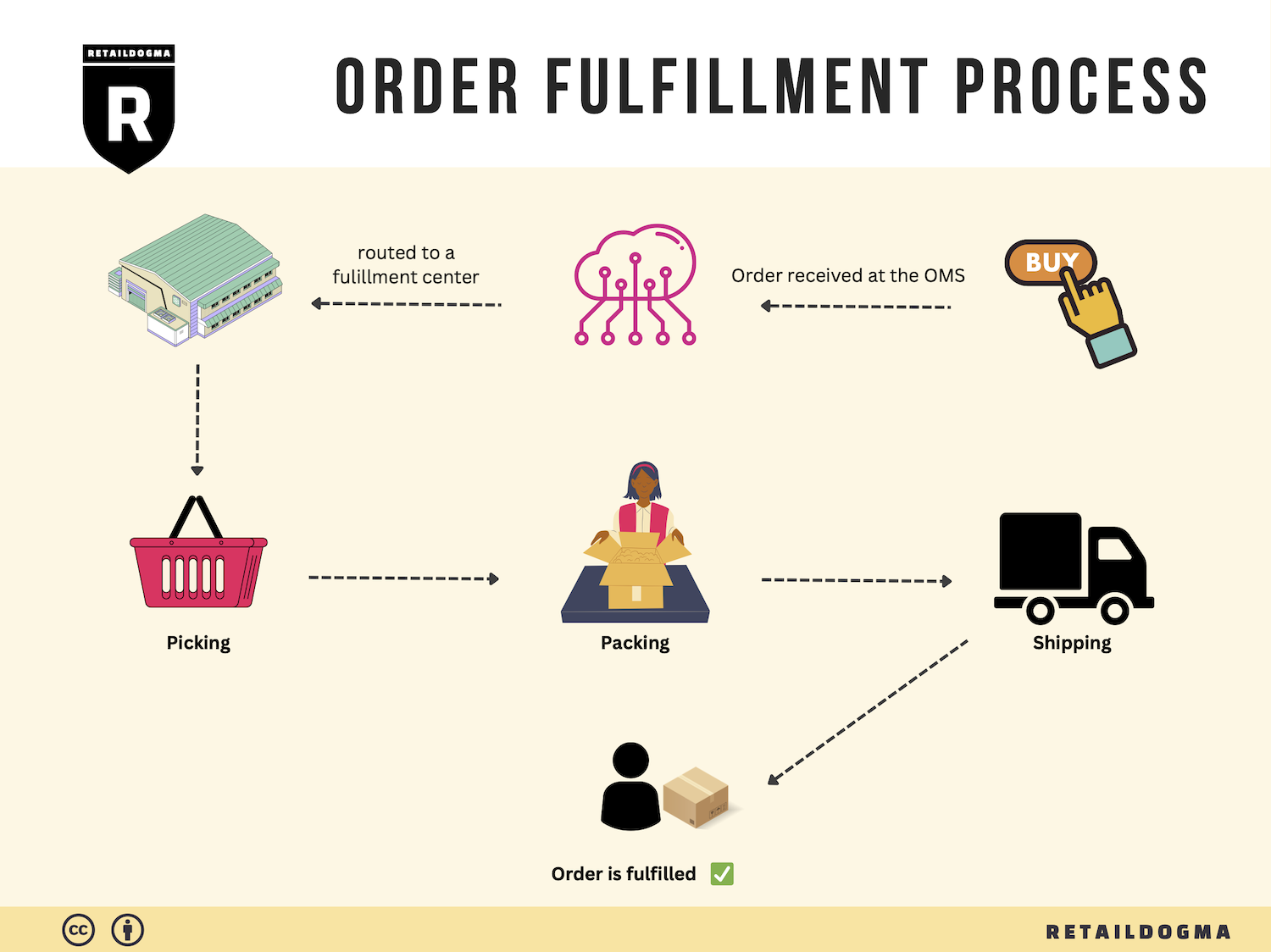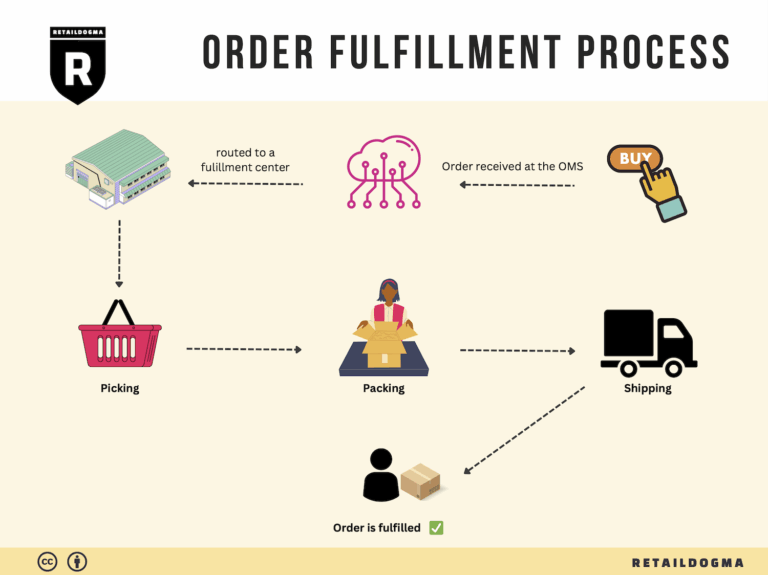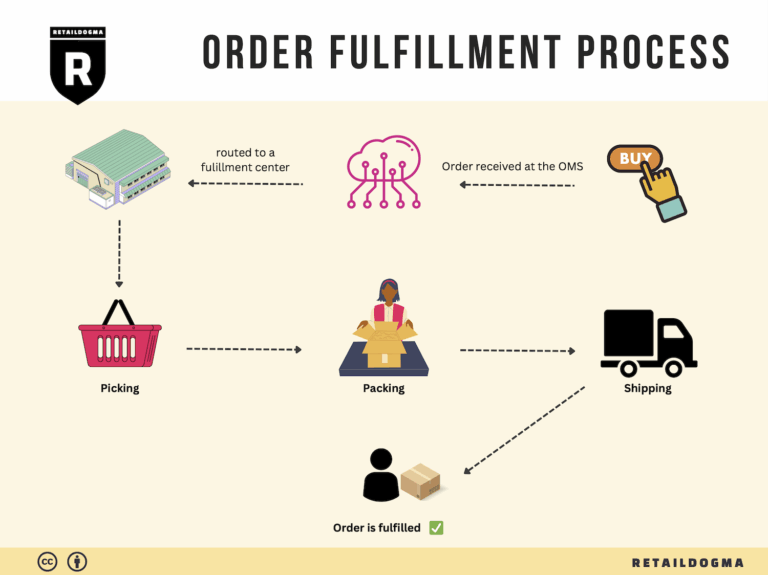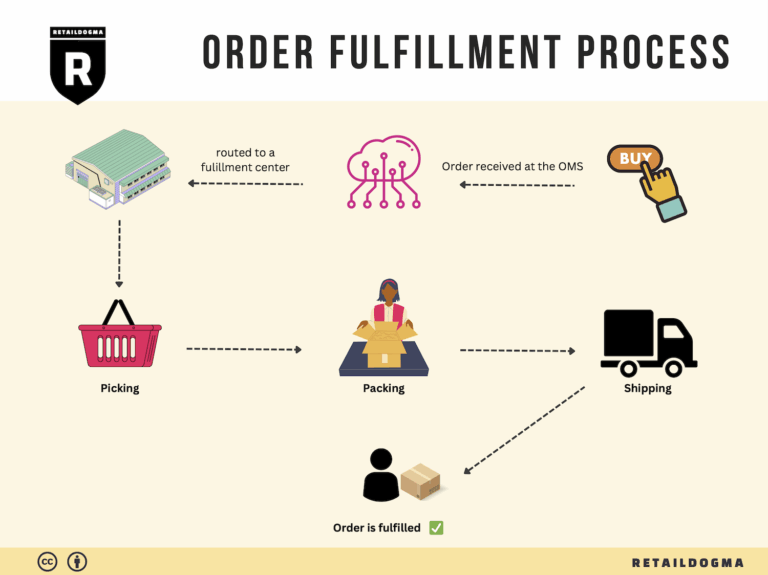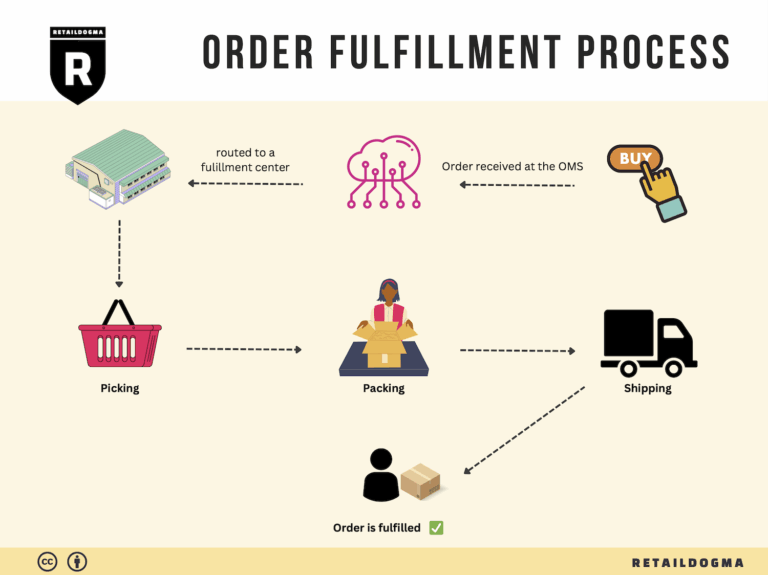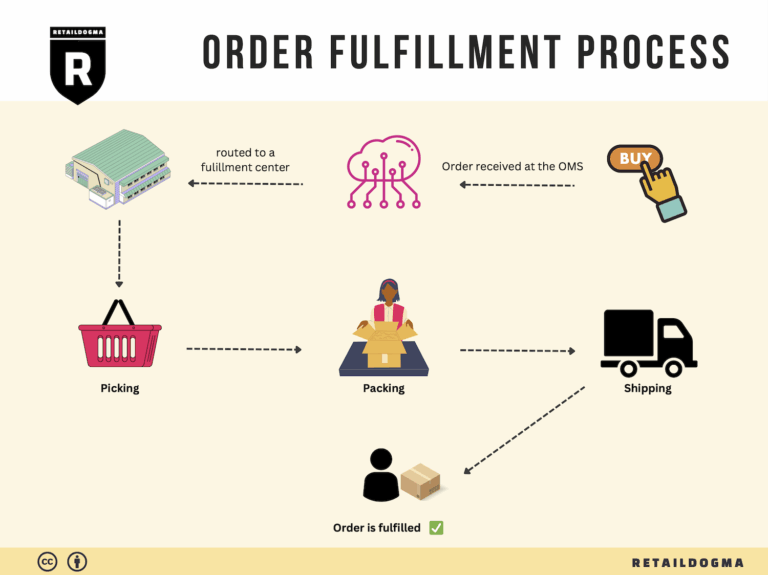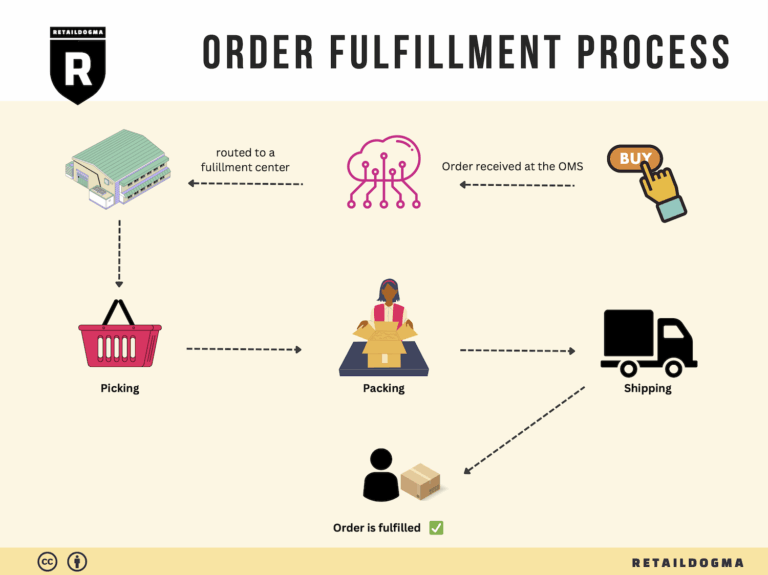How Order Fulfillment Works: A Step-by-Step Guide for Businesses
What is E-commerce Fulfillment? An Introduction for Growing Businesses
Understanding E-commerce Fulfillment
For many growing online businesses, the excitement of increased sales can quickly turn into an overwhelming burden when it comes to packing and shipping orders. Managing logistics can be a daunting task, often taking valuable time away from scaling your business and enhancing customer experiences. E-commerce fulfillment is the solution to this common pain point, defined simply as the entire process of getting a product from your inventory to your customer’s doorstep.
This guide aims to demystify e-commerce fulfillment, providing insights and strategies tailored for businesses looking to optimize their logistics. We will explore various fulfillment models, including Third-Party Logistics (3PL) and Fulfillment by Amazon (FBA), each offering unique advantages and operational frameworks. Understanding these models will help you determine which aligns best with your business needs and growth objectives.
In addition to models, we will delve into the core services provided by fulfillment partners. These services typically encompass inventory storage, order processing, packing, shipping, and returns management. By understanding these components, you can better assess potential partners and their capabilities in meeting your specific requirements.
Choosing the right fulfillment partner is crucial for your success. We will outline key criteria to consider, such as reliability, scalability, technological integration, and customer service. A strategic partnership can enhance your operational efficiency and ultimately contribute to customer satisfaction.
Pricing structures in e-commerce fulfillment can vary significantly based on the services offered and the fulfillment model chosen. We will break down common pricing strategies, including per-order fees, storage fees, and shipping costs, enabling you to anticipate expenses and budget effectively.
The ultimate goal of this guide is to empower you, the business owner, to make informed decisions about your logistics and fulfillment strategies. By understanding the intricacies of e-commerce fulfillment, you can streamline operations, reduce costs, and focus on what truly matters: growing your business and delighting your customers. Whether you are just starting out or looking to scale, this guide will provide the knowledge and tools you need to navigate the complexities of e-commerce fulfillment with confidence.
What You’ll Learn In This Guide
- What is E-commerce Fulfillment? An Introduction for Growing Businesses
- The Order Fulfillment Process: From ‘Buy’ Button to Customer’s Door
- Comparing Fulfillment Models: In-House vs. 3PL vs. Dropshipping
- A Deep Dive into Amazon FBA: Pros, Cons, and Who It’s For
- Core Services Offered by Fulfillment Centers
- How to Choose a Fulfillment Partner: A 6-Point Checklist
- Understanding Fulfillment Pricing: A Breakdown of Common Fees
- Frequently Asked Questions (FAQs) about Fulfillment
- Conclusion: Is Outsourcing Fulfillment the Right Move for Your Business?
- Important Disclaimer
The Order Fulfillment Process: From ‘Buy’ Button to Customer’s Door
1. Receiving Inventory
The order fulfillment process begins with receiving inventory at the fulfillment center. This step involves checking the incoming shipments against purchase orders to ensure that the right quantity and type of products have arrived. Key terms associated with this step include SKU (Stock Keeping Unit), which is a unique identifier for each product that helps in tracking inventory levels.
Proper inventory receiving is crucial for maintaining stock accuracy. If discrepancies are found—such as damaged goods or incorrect quantities—these issues must be resolved immediately to prevent disruptions later in the fulfillment process. This initial step sets the foundation for efficient operations, as accurate inventory data is essential for effective order management and customer satisfaction.
2. Warehouse Storage
Once the inventory is received and verified, the next phase is warehouse storage. This involves placing the products in designated storage areas within the fulfillment center. Effective warehouse storage utilizes a systematic approach, often based on a bin location system that organizes products by categories or demand frequency.
The importance of this step lies in optimizing space and facilitating easy access to items when orders come in. Efficient storage solutions not only maximize the use of warehouse space but also minimize the time employees spend locating products. Implementing an effective inventory management system can further enhance this process, allowing businesses to track stock levels in real-time and streamline restocking efforts.
3. Order Picking
Following storage, the next step is order picking, where staff or automated systems retrieve items from the warehouse based on customer orders. This process often uses pick lists, which are documents that specify the items and quantities required for each order.
Order picking is a critical phase as it directly impacts order accuracy and fulfillment speed. Mistakes made during this stage can lead to incorrect shipments, resulting in customer dissatisfaction and increased return rates. To enhance efficiency, many fulfillment centers employ technologies such as barcode scanners or pick-to-light systems, which guide pickers to the exact location of the items, ensuring quick and accurate retrieval.
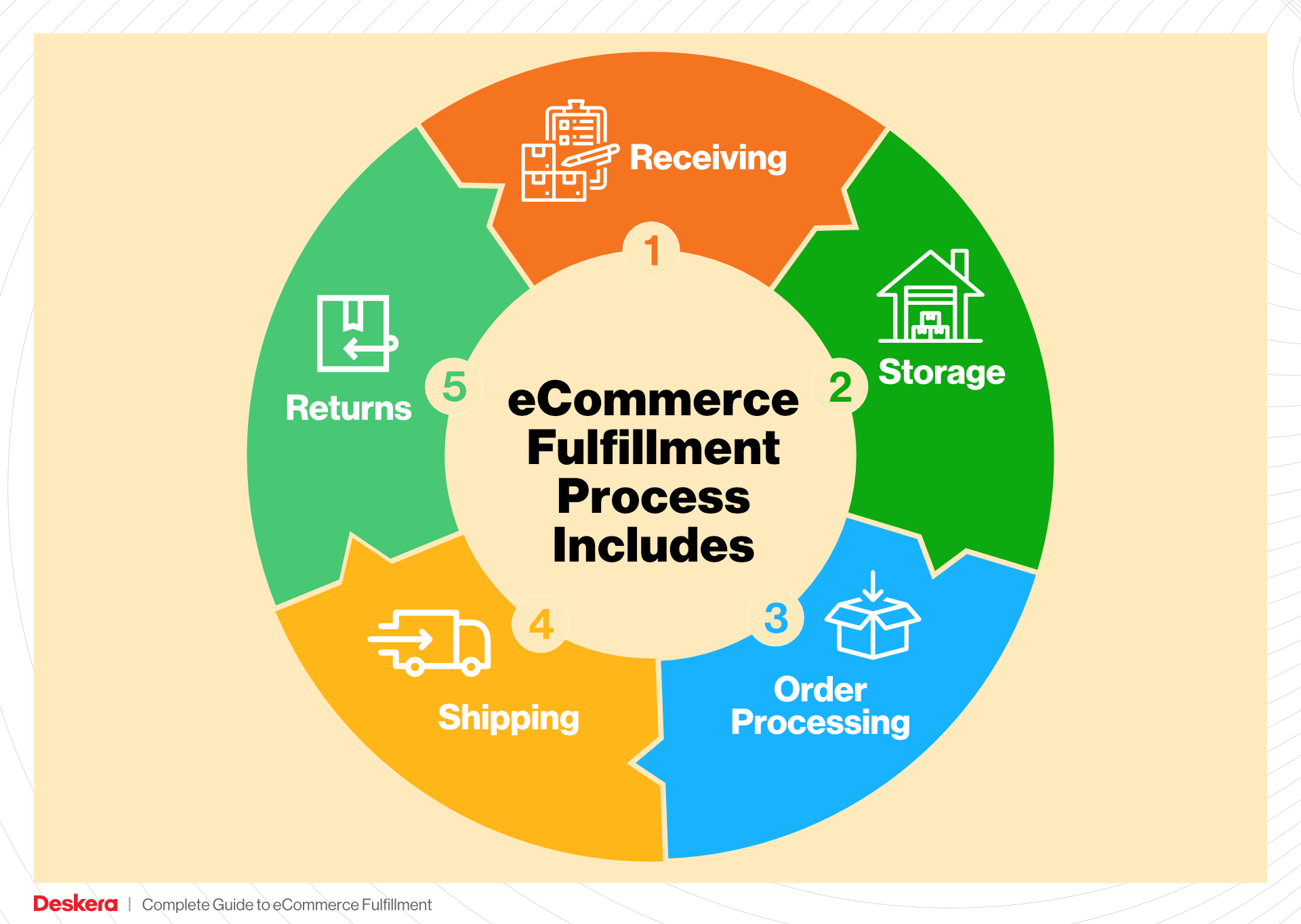
4. Order Packing
After items are picked, they move to the order packing stage. Here, products are carefully packed into boxes, ensuring they are protected for shipment. This step is vital for preventing damage during transit and involves using appropriate packing materials, such as bubble wrap, packing peanuts, or custom-sized boxes.
The packing process also includes generating shipping labels and packing slips, which provide important information for both the carrier and the customer. This phase is essential for maintaining brand integrity; well-packed orders reflect a company’s commitment to quality and can enhance customer satisfaction. Additionally, employing packing optimization software can reduce shipping costs by determining the most efficient way to pack items.
5. Shipping & Delivery
The final step in the fulfillment process is shipping and delivery. Once the orders are packed, they are handed over to shipping carriers for delivery to customers. This stage is critical as it determines how quickly customers receive their products, which directly affects their overall shopping experience.
Key terms in this phase include last-mile delivery, which refers to the final leg of the shipping process where the package is delivered to the customer’s door. Efficient last-mile delivery is essential for meeting customer expectations, particularly in today’s e-commerce environment where rapid delivery options are increasingly demanded. Businesses can enhance their shipping strategies by partnering with reliable carriers, utilizing tracking systems, and offering multiple delivery options to cater to various customer needs.
By understanding and optimizing each of these five steps in the order fulfillment process, e-commerce businesses can significantly improve their operational efficiency, reduce costs, and enhance customer satisfaction, ultimately driving sales growth.

Comparing Fulfillment Models: In-House vs. 3PL vs. Dropshipping
Fulfillment Model Comparison
| Model | Who Handles Inventory | Best For (Business Stage) | Key Advantage | Key Disadvantage |
|---|---|---|---|---|
| In-House Fulfillment | Business owns and manages | Established businesses with stable sales | Full control over inventory and operations | High overhead costs and scalability limitations |
| Third-Party Logistics (3PL) | 3PL provider manages inventory | Growing businesses seeking efficiency | Cost-effective scalability and expertise | Less control over inventory and operations |
| Dropshipping | Supplier manages inventory | Startups and small businesses | Low startup costs and minimal risk | Lower profit margins and potential supply chain issues |
In-House Fulfillment
In-house fulfillment refers to when a business takes full responsibility for managing its inventory, warehousing, order processing, and shipping. This model is often favored by established businesses with a steady sales volume, as it allows for complete control over the entire fulfillment process. Companies can tailor their operations to fit their specific needs, ensuring quality and consistency in order fulfillment. Additionally, having direct oversight of inventory can lead to improved customer service and faster response times to market changes.
However, the in-house model comes with significant challenges. The overhead costs can be quite high, as businesses must invest in warehousing, staffing, and technology. This can limit scalability, especially for companies looking to expand rapidly. Furthermore, managing logistics can distract from core business activities, such as product development and marketing. For businesses with fluctuating sales volumes or those just starting, the in-house model may not be the most efficient option.
Third-Party Logistics (3PL)
Third-party logistics (3PL) involves outsourcing fulfillment operations to a specialized provider. This model is particularly beneficial for growing businesses that want to streamline their logistics without the burden of managing inventory and warehousing directly. A 3PL provider offers the expertise and resources to handle everything from storage and order processing to shipping and returns. This allows businesses to focus on their core competencies while leveraging the logistics provider’s capabilities to scale operations more efficiently.
One of the primary advantages of using a 3PL is cost-effectiveness. By outsourcing logistics, businesses can avoid the substantial upfront costs associated with warehousing and staffing. Additionally, 3PLs often have established relationships with carriers, enabling them to negotiate better shipping rates. However, the downside is that businesses relinquish some control over their inventory and fulfillment processes. This can lead to challenges in maintaining quality control and consistency in customer service. For companies that prioritize flexibility and growth, finding a reliable 3PL partner is crucial.
Dropshipping
Dropshipping is a fulfillment model where the retailer does not keep products in stock but instead transfers customer orders directly to a supplier, who then ships the products on behalf of the retailer. This model is particularly attractive to startups and small businesses due to its low startup costs and minimal risk. Entrepreneurs can launch their online stores without investing heavily in inventory, allowing them to test product viability and market demand before committing to larger stock purchases.
The primary advantage of dropshipping is the reduced financial risk and low overhead costs. Since businesses do not have to manage inventory or shipping, they can focus on marketing and customer acquisition. However, dropshipping also comes with notable disadvantages. Profit margins tend to be lower compared to other fulfillment models, as suppliers typically charge higher prices for their services. Additionally, businesses have less control over inventory management and shipping times, which can lead to customer dissatisfaction if suppliers experience delays. For those considering dropshipping, it’s essential to choose reliable suppliers and to establish clear communication to mitigate potential issues.

Conclusion
In summary, choosing the right fulfillment model is a critical decision that can significantly impact the success of an e-commerce business. Each model—In-House Fulfillment, 3PL, and Dropshipping—comes with its own set of advantages and challenges. Business owners must evaluate their specific needs, growth stage, and operational capabilities to select the most suitable option for their logistics strategy. By understanding the nuances of each fulfillment model, businesses can better position themselves for scalability and success in the competitive e-commerce landscape.
A Deep Dive into Amazon FBA: Pros, Cons, and Who It’s For
Understanding Fulfillment by Amazon (FBA)
Fulfillment by Amazon (FBA) is a service offered by Amazon that allows sellers to store their products in Amazon’s fulfillment centers. Amazon takes care of storage, packaging, shipping, and customer service on behalf of the sellers. This service provides sellers with the ability to leverage Amazon’s vast logistics network, making it an attractive option for many e-commerce businesses looking to scale.
How FBA Works
-
Product Listing and Inventory Management: Sellers create a product listing on Amazon and send their inventory to Amazon’s fulfillment centers. Amazon provides shipping guidelines to ensure products arrive safely and in compliance with their standards.
-
Storage: Once the products arrive at an Amazon fulfillment center, they are stored until an order is placed. Amazon manages the inventory, ensuring it is organized and easily accessible.
-
Order Fulfillment: When a customer places an order for a product that is fulfilled by FBA, Amazon picks, packs, and ships the product directly to the customer. This is where Amazon’s extensive logistics capabilities come into play, allowing for fast and reliable delivery.
-
Customer Service and Returns: Amazon also handles customer service inquiries and returns for FBA products, providing a seamless experience for both sellers and buyers.
-
Prime Eligibility: Products fulfilled by Amazon are automatically eligible for Amazon Prime, which can significantly increase visibility and sales potential.
Pros of Using FBA
1. Prime Eligibility
Products fulfilled by Amazon qualify for Amazon Prime, which offers free two-day shipping to Prime members. This can lead to increased sales, as many customers prefer to buy products that are Prime-eligible.
2. Customer Trust
Selling through FBA can enhance customer trust. Buyers often feel more secure purchasing items that are backed by Amazon’s customer service and return policies. The Amazon brand is synonymous with reliability, and this can translate into higher conversion rates for sellers.
3. Multi-Channel Fulfillment
FBA allows sellers to fulfill orders not only on Amazon but also from their own e-commerce websites and other marketplaces. This multi-channel fulfillment capability means sellers can streamline their operations and manage inventory more efficiently.
4. Scalability
FBA provides businesses with the ability to scale quickly without the need to invest in warehousing, staffing, or logistics. This can be particularly advantageous for small businesses or startups looking to grow.
5. Simplified Logistics
By outsourcing logistics to Amazon, sellers can focus more on product development and marketing rather than on the complexities of shipping and handling.
Cons of Using FBA
1. High Fees
While FBA offers many benefits, it comes at a cost. Amazon charges various fees for storage and fulfillment services, which can eat into profit margins. Sellers must carefully analyze these costs to determine if FBA is financially viable for their business model.
2. Strict Inventory Rules
Amazon has stringent rules regarding inventory management. Sellers must adhere to guidelines concerning storage limits, inventory performance metrics, and restocking frequency. Failure to comply can result in penalties or account suspension.
3. Commingling Risks
FBA products may be commingled with inventory from other sellers. This means that when an order is fulfilled, a product from another seller could be shipped to the customer instead of the seller’s own product. This can lead to brand integrity issues and complications with returns and refunds.
4. Less Control Over Fulfillment
When using FBA, sellers relinquish a degree of control over how their products are stored, packaged, and shipped. This can be a concern for brands that prioritize a specific presentation or packaging method.
5. Long-Term Storage Fees
If inventory does not sell within a certain timeframe, sellers may incur long-term storage fees. This can be particularly problematic for seasonal products or items with slower sales velocity.
Who is FBA Best For?
Fulfillment by Amazon is particularly beneficial for:
-
Small to Medium-Sized Businesses: Businesses looking to scale quickly without the burden of managing logistics can benefit significantly from FBA.
-
E-commerce Entrepreneurs: New sellers who want to enter the e-commerce space with minimal upfront investment in warehousing and logistics will find FBA a helpful option.
-
Brands Seeking to Increase Visibility: Companies that want to leverage Amazon’s vast customer base and gain access to Prime members will find FBA advantageous.
-
Sellers with High Sales Volume: Businesses that have the potential for high sales volume can take advantage of FBA’s efficient logistics to handle order fulfillment seamlessly.
In conclusion, while Fulfillment by Amazon offers numerous advantages that can facilitate growth and efficiency for e-commerce businesses, it is essential for sellers to weigh the pros and cons carefully. Understanding the associated costs, rules, and risks will help businesses make informed decisions about whether FBA aligns with their operational goals and customer service standards.
Core Services Offered by Fulfillment Centers
Inventory Management & Warehousing
Inventory management and warehousing are foundational services provided by fulfillment centers, ensuring that e-commerce businesses maintain optimal stock levels and have organized storage solutions. This service includes the systematic tracking of inventory levels, orders, sales, and deliveries. Fulfillment centers utilize advanced inventory management systems that provide real-time data on stock levels, allowing businesses to make informed decisions about restocking and inventory turnover.
Benefits:
– Enhanced Visibility: Businesses gain a clear view of their inventory status, which helps in avoiding stockouts or overstock situations. This visibility is crucial for maintaining customer satisfaction and meeting demand without excessive holding costs.
– Space Optimization: Fulfillment centers often employ efficient storage solutions, such as automated shelving and dynamic storage systems, which maximize space utilization. This leads to reduced warehousing costs and improved operational efficiency.
– Scalability: As e-commerce businesses grow, so do their inventory needs. Fulfillment centers provide the flexibility to scale operations without the need for significant investments in additional warehousing infrastructure.
Pick and Pack Services
Pick and pack services are integral to the order fulfillment process, where items are selected from inventory (picked) and prepared for shipment (packed). Fulfillment centers utilize technology-driven processes to ensure accuracy and efficiency during this stage. This service typically involves the use of barcode scanning and automated systems to reduce errors and speed up order processing.
Benefits:
– Efficiency: Streamlined pick and pack operations allow businesses to process large volumes of orders quickly, which is essential for meeting customer expectations for fast delivery.
– Accuracy: Automated systems minimize human error in order fulfillment, ensuring that customers receive the correct items. This accuracy leads to increased customer satisfaction and reduced return rates.
– Customization: Fulfillment centers can accommodate special packaging requests, such as branded packaging or gift wrapping, enhancing the customer experience and allowing businesses to differentiate themselves in a competitive market.
Kitting and Assembly
Kitting and assembly services involve combining multiple products into a single package or kit before shipment. This service is particularly beneficial for businesses that offer bundled products or require assembly of components before sending them to customers. Fulfillment centers can efficiently manage this process, ensuring that products are assembled according to specifications and ready for delivery.
Benefits:
– Streamlined Operations: By outsourcing kitting and assembly to fulfillment centers, businesses can focus on their core competencies while ensuring that complex orders are handled efficiently. This can lead to significant time savings and increased productivity.
– Value Addition: Offering kits or assembled products can enhance perceived value for customers, potentially leading to higher sales and customer loyalty. Fulfillment centers enable businesses to create appealing product offerings without the need for extensive in-house resources.
– Reduced Complexity: Managing kitting and assembly in-house can be complicated and resource-intensive. Fulfillment centers simplify this process, allowing businesses to adapt quickly to changes in demand or product offerings.
Returns Management (Reverse Logistics)
Returns management, or reverse logistics, is a critical service provided by fulfillment centers that focuses on handling returned merchandise efficiently. This process includes receiving, inspecting, restocking, or disposing of returned items. Effective returns management is vital for maintaining customer satisfaction and recovering value from returned products.
Benefits:
– Customer Satisfaction: A streamlined returns process enhances the overall customer experience, as consumers appreciate hassle-free return policies. This can lead to increased trust and repeat business.
– Cost Recovery: Fulfillment centers are equipped to efficiently process returns, which can help recover value from returned items through restocking or refurbishing. This capability reduces losses associated with returns and supports overall profitability.
– Data Insights: Analyzing return data can provide valuable insights into product quality and customer preferences. Fulfillment centers can assist businesses in identifying trends in returns, enabling them to make informed decisions about product offerings and improvements.
In summary, fulfillment centers provide a range of core services that are essential for e-commerce businesses looking to scale effectively. By leveraging inventory management, pick and pack services, kitting and assembly, and returns management, businesses can enhance their operational efficiency, improve customer satisfaction, and ultimately drive growth in a competitive market.
How to Choose a Fulfillment Partner: A 6-Point Checklist
Location & Warehouse Network
Importance: The geographical location of your fulfillment partner is crucial for ensuring timely deliveries and minimizing shipping costs. A partner with warehouses strategically located near your target markets can significantly reduce transit times and enhance customer satisfaction.
Questions to Ask:
– Where are your warehouses located, and how does this align with our customer base?
– What is your average shipping time to key regions we serve?
– Do you have plans for expanding your warehouse network in the near future?
Technology & Integrations
Importance: In the fast-paced world of e-commerce, technology plays a vital role in streamlining operations. A fulfillment partner should offer robust technology solutions that integrate seamlessly with your existing systems, such as your e-commerce platform, inventory management software, and customer relationship management tools.
Questions to Ask:
– What technology do you use for order processing and inventory management?
– Can your system integrate with our existing software? If so, what platforms do you support?
– How do you ensure data security and compliance with regulations?
Specializations (e.g., cold storage, oversized items)
Importance: Different products have unique storage and handling requirements. If your business deals with specialized items, such as perishables or oversized goods, it’s essential to partner with a fulfillment provider that has the necessary facilities and expertise.
Questions to Ask:
– Do you have specialized facilities for handling our type of products (e.g., cold storage, hazardous materials)?
– What experience do you have in managing the logistics of our specific product categories?
– Can you provide examples of how you have successfully fulfilled similar product types for other clients?
Scalability & Capacity
Importance: As your business grows, your fulfillment needs will change. A capable partner should be able to scale with you, whether that means handling increased order volumes during peak seasons or expanding into new markets.
Questions to Ask:
– How do you manage peak seasons or unexpected surges in order volume?
– What is your current capacity, and how do you plan to scale in the future?
– Can you provide a case study of how you have supported a client through a significant growth phase?
Pricing and Contracts
Importance: Understanding the pricing structure and contract terms is essential to ensure that you are getting a fair deal. Look for transparency in pricing and be wary of hidden fees that can affect your bottom line.
Questions to Ask:
– What is your pricing structure (e.g., per order, per item, monthly fees)?
– Are there any additional fees we should be aware of (e.g., storage fees, handling fees, shipping costs)?
– What are the terms of the contract, and is there flexibility for renegotiation as our needs change?
Customer Support & Reviews
Importance: Exceptional customer support can make a significant difference in your partnership. A responsive and knowledgeable support team can help resolve issues quickly and keep your operations running smoothly. Additionally, reviews and testimonials from other clients can provide insight into the partner’s reliability and service quality.
Questions to Ask:
– What type of customer support do you offer (e.g., dedicated account manager, 24/7 support)?
– How do you handle issues or discrepancies with orders?
– Can you provide references or case studies from current or past clients?
In conclusion, choosing the right fulfillment partner is a critical decision that can impact your e-commerce business’s efficiency, customer satisfaction, and growth potential. By carefully considering these six key areas and asking the right questions, you can make an informed decision that aligns with your business objectives and positions you for success in the competitive e-commerce landscape.
Understanding Fulfillment Pricing: A Breakdown of Common Fees
Initial Setup Fees
When partnering with a fulfillment center, the initial setup fees are often the first costs to consider. These fees cover the administrative and operational processes required to onboard your business into the fulfillment system. Setup may include account creation, integration of inventory management systems, and training on how to use the fulfillment platform effectively.
Typically, initial setup fees can range from a few hundred to several thousand dollars, depending on the complexity of your operation and the fulfillment provider’s capabilities. Some providers may waive these fees if you commit to a long-term contract or meet certain volume thresholds.
Receiving Fees
Receiving fees are charged when your inventory arrives at the fulfillment center. This fee covers the cost of unloading, inspecting, and entering your products into the inventory management system. The calculation is generally based on the volume or weight of the shipment.
For example, a fulfillment center might charge a flat fee per pallet or per item received. This fee can vary significantly depending on the facility’s location, the type of products being received, and the efficiency of the operation. Understanding this fee is crucial, especially if your business involves frequent shipments.
Storage Fees (per pallet/bin)
Storage fees are incurred for the space your inventory occupies within the fulfillment center. These fees are typically calculated on a per pallet or per bin basis, often charged monthly. The rates can vary based on factors such as the size of the pallet, the type of products stored (perishable items may incur higher rates), and the duration of storage.
For instance, if a fulfillment center charges $20 per pallet per month and you store 10 pallets, your monthly storage fee would be $200. It’s essential to monitor your inventory turnover rates closely; high storage fees can significantly erode your profit margins, especially if items remain unsold for extended periods.
Pick & Pack Fees (per item/order)
Pick and pack fees are one of the most significant costs associated with fulfillment services. These fees cover the labor involved in picking items from the warehouse and packing them for shipment. Charges can vary depending on whether the fee is calculated per item or per order, with some providers offering tiered pricing based on order volume.
For example, a fulfillment center may charge $1.50 per item picked and packed. If an order contains three items, the total pick and pack fee would be $4.50. Understanding this fee structure is vital, as it can have a direct impact on your pricing strategy and profit margins. Implementing efficient inventory management practices can help reduce the number of picks and ultimately lower these costs.
Shipping Fees
Shipping fees are the costs associated with delivering the packaged orders to customers. These fees can be influenced by several factors, including the shipping method selected (standard, expedited, etc.), the weight and dimensions of the package, and the destination.
Fulfillment centers often negotiate shipping rates with carriers, and these rates can vary widely. It’s essential to understand how your provider calculates shipping fees—some may offer flat-rate shipping, while others might charge based on real-time carrier rates. Additionally, consider how shipping fees affect your overall pricing strategy; offering free shipping can drive sales but may require absorbing these costs into your pricing.
Conclusion: Tips for Getting an Accurate Quote
To obtain an accurate fulfillment pricing quote, consider the following tips:
-
Be Specific About Your Needs: Clearly outline your product types, average order sizes, and expected monthly volume. This information helps providers offer tailored quotes.
-
Ask for Detailed Breakdowns: Request a line-item breakdown of all potential fees, including any variable costs based on order size or weight.
-
Negotiate Terms: Don’t hesitate to negotiate fees, especially if you anticipate high order volumes. Some providers may offer discounts or lower rates for long-term contracts.
-
Consider Hidden Costs: Inquire about any additional costs that may arise, such as returns processing or additional handling fees, to avoid surprises later.
-
Utilize Technology: Leverage inventory management and analytics tools to monitor your fulfillment costs continually. This data can help you optimize your logistics and negotiate better terms with providers.
By understanding these common fulfillment pricing models and following these tips, you can make informed decisions that will help your e-commerce business scale effectively and profitably.
Frequently Asked Questions (FAQs) about Fulfillment
1. What is the Amazon Fulfillment Center in Monee, IL?
The Amazon Fulfillment Center in Monee, IL, is a large-scale facility that specializes in storing, packing, and shipping a diverse range of products for Amazon. It plays a crucial role in Amazon’s logistics operations, enabling efficient processing and delivery of orders to customers across the region.
2. How does the fulfillment process work at Amazon’s Monee facility?
The fulfillment process at Amazon’s Monee facility involves receiving inventory, storing products in designated areas, picking items for customer orders, packing them securely, and shipping them out. Advanced technologies, including robotics and automated systems, are utilized to enhance efficiency and accuracy in handling high volumes of orders.
3. What is the difference between a warehouse and a fulfillment center?
A warehouse is primarily used for storage and inventory management, while a fulfillment center focuses on the processing of orders and shipping directly to customers. Fulfillment centers typically incorporate advanced logistics technology to streamline operations, ensuring quicker delivery times and improved order accuracy.
4. What is a Third-Party Logistics Provider (3PL)?
A Third-Party Logistics Provider (3PL) is a service provider that manages logistics and supply chain operations for businesses. This includes warehousing, order fulfillment, transportation, and inventory management. Companies often partner with 3PLs to leverage their expertise and resources, allowing them to scale operations without the need for significant capital investment.
5. How much do fulfillment services cost?
The cost of fulfillment services can vary widely based on factors such as order volume, storage space, packaging requirements, and shipping destinations. Generally, businesses can expect to pay for storage (per pallet or cubic foot), picking and packing fees (per order or item), and shipping costs. It’s advisable to request quotes from multiple providers to understand the pricing structure that best fits your business model.
6. What types of products are handled at the Monee fulfillment center?
The Monee fulfillment center handles a wide range of products, from electronics and household items to clothing and toys. This versatility allows Amazon to cater to diverse customer needs and preferences, enhancing the overall shopping experience.
7. Are there any special promotions or services offered by the Monee fulfillment center?
Yes, the Monee fulfillment center participates in special promotions such as Prime Day and seasonal sales, offering exclusive deals and discounts on a variety of items. Additionally, the facility ensures compliance with safety regulations, enhancing customer trust and satisfaction.
8. How does Amazon ensure fast delivery from the Monee facility?
Amazon employs advanced logistics and technology, including automated picking systems and a robust transportation network, to ensure quick delivery from the Monee fulfillment center. The strategic location of the center in Illinois, a key logistics hub, further facilitates efficient distribution across the region.
9. What employment opportunities are available at the Monee fulfillment center?
The Monee fulfillment center offers a range of employment opportunities, from warehouse associates and management positions to roles in logistics and operations. With the facility’s expansion, there is potential for thousands of new jobs in the area, contributing to local economic growth.
10. How can e-commerce businesses benefit from using Amazon’s fulfillment services?
E-commerce businesses can benefit from Amazon’s fulfillment services by leveraging their vast logistics network, advanced technology, and expertise in order processing. This allows businesses to focus on growth and customer acquisition while ensuring that orders are fulfilled quickly and accurately, ultimately enhancing customer satisfaction and loyalty.
Conclusion: Is Outsourcing Fulfillment the Right Move for Your Business?
Evaluating the Benefits of Outsourcing Fulfillment
As you contemplate the future of your e-commerce business, outsourcing fulfillment can be a transformative strategy that offers several compelling advantages. Firstly, by leveraging the expertise of a fulfillment partner, you can save significant time and resources. Instead of managing logistics, warehousing, and shipping in-house, you can focus on core activities such as marketing, product development, and customer engagement. This shift allows you to allocate your time more effectively and drive growth.
Secondly, scalability is a crucial benefit of utilizing a fulfillment service. As your business grows, so does the complexity of your logistics. A dedicated fulfillment partner provides the infrastructure needed to seamlessly scale your operations, accommodating increased order volumes without the need for substantial investments in physical space or technology. This flexibility is particularly advantageous during peak seasons or promotional events, where demand can fluctuate dramatically.
Moreover, fulfillment centers, such as those found in Monee, IL, are equipped with advanced technology and streamlined processes that ensure accuracy and efficiency in order processing. By tapping into their expertise, you can enhance your customer experience through faster delivery times and reliable service.
However, the success of outsourcing fulfillment hinges on choosing the right partner. Look for a provider that aligns with your business goals, offers transparent pricing, and demonstrates a commitment to customer satisfaction. The right partner will not only facilitate growth but will also enhance your brand’s reputation.
Strategic Call-to-Action
To determine if outsourcing fulfillment is the right step for your business, conduct a thorough audit of your current shipping and logistics processes. Assess areas where inefficiencies exist and consider how a fulfillment partner could streamline your operations. This proactive approach will help you make an informed decision and set the stage for sustainable growth.
Important Disclaimer
⚠️ Important Disclaimer
The information in this guide is for educational purposes. Fulfillment services, pricing, and platform features change frequently. Always conduct your own due diligence and consult with providers directly before making business decisions.
